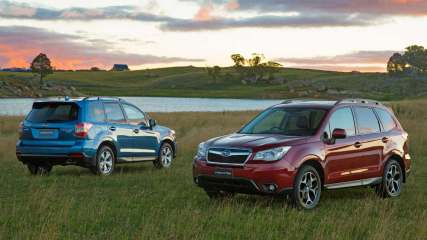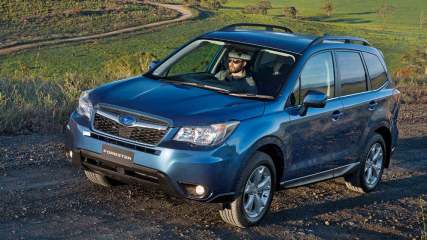2025 Subaru Forester Reviews
You'll find all our 2025 Subaru Forester reviews right here. 2025 Subaru Forester prices range from $38,690 for the Forester 25i Awd to $55,990 for the Forester Hybrid Touring Awd.
Our reviews offer detailed analysis of the 's features, design, practicality, fuel consumption, engine and transmission, safety, ownership and what it's like to drive.
The most recent reviews sit up the top of the page, but if you're looking for an older model year or shopping for a used car, scroll down to find Subaru dating back as far as 1997.
Or, if you just want to read the latest news about the Subaru Forester, you'll find it all here.
Subaru Forester Reviews
.jpg)
Subaru Forester 2.5i-S 2016 review
Read the article
By Craig Jamieson · 18 Apr 2016
Craig Jamieson road tests and reviews the Subuaru Forester 2.5i-S with specs, fuel consumption and verdict.
.jpg)
Subaru Forester 2.5i-S 2016 review
Read the article
By Richard Blackburn · 08 Apr 2016
Richard Blackburn road tests and reviews the Subaru Forester 2.5i-S with specs, fuel consumption and verdict.
.jpg)
Subaru Forester 2016 review
Read the article
By Marcus Craft · 26 Feb 2016
Marcus Craft road tests and reviews the Subaru Forester with specs, fuel consumption and verdict at its Australian launch.
.jpg)
Subaru Forester 2.0D-L 2015 review
Read the article
By Derek Ogden · 04 Jun 2015
Derek Ogden road tests and reviews the 2015 Subaru Forester 2.0D-L, with specs, fuel consumption and verdict.

Subaru Forester diesel auto 2015 review
Read the article
By Chris Riley · 20 May 2015
Chris Riley road tests and reviews the Subaru Forester diesel with specs, fuel consumption and verdict.
.jpg)
Mazda CX-5, Toyota RAV4 and Subaru Forester diesel 2015 Review | midsize SUV comparison
Read the article
By Richard Blackburn · 17 Apr 2015
Most SUVs are made for the suburbs, but some still cater for those looking to live the great Aussie dream.

Subaru Forester 2.0D 2015 review
Read the article
By Derek Ogden · 06 Apr 2015
With the loudest cooee coming from the bush, Subaru has answered the call by adding a diesel automatic to its model year 2015 Forester range, as well as chopping prices by up to $3500, the latter on top of the $1000 trim announced at the beginning of this year.At the launch of the realigned range, Subaru Australia managing director Nick Senior, said: "We know through our dealer network there is significant pent-up demand for Forester auto diesels, not least in regional and rural areas, where the benefits of fuel efficiency in long-range driving really come to the fore."Mr Senior said the addition of the continuously variable automatic transmission was a huge boost to the range and he predicted sales of around 200 Forester 2.0D automatics per month.For 2015, improvements have been made to the Forester's horizontally opposed turbocharged 2.0-litre diesel boosting power output to 108kW at 3600 rpm and 350Nm of torque between 1600 and 2400 revs.It complies with strict Euro 6 exhaust emission standards, fuel efficiency is improved and vibration reduced. The high torque is taken care of with the Subaru Lineartronic CVT featuring a step-shifting control method linked to engine speed.The system switches between continuously variable operation to step shifting. With the transmission in D mode, if the accelerator is depressed by more than 65 per cent, a seven-speed step shift activates. If the movement is less than 65 per cent, stepless CVT operates.Unlike many of its rivals such as the Mazda CX-5, Toyota RAV4 and Kia Sportage, that have gone in for a slick profile, the MY15 Forester errs on the side of tradition, leaning more to the original squared off wagon shape.The fuel efficiency display is now designed to make occupants more aware of economical drivingInside, it's a different matter. Across the range there has been a lift in attention to detail, with particular reference to the most used components such as centre panel and steering wheel controls, and air vent grilles.Silver and contrasting piano black surrounds make for a sumptuous yet striking appearance, while the instrument panel combines upgraded audio display and, in the upper-spec models, factory-fitted satellite navigation in the central dashboard.The multifunction display incorporates both digital and analogue clock, while the fuel efficiency display is now designed to make occupants more aware of economical driving.Depending on model, infotainment is boosted by more intuitive functions for media playback, including Pandora connectivity, and information access, with smartphone-style 7-inch touchscreen incorporating flick, pinch and double-tap functions, list selections using steering wheel switches, plus voice recognition.The entry-level Forester 2.0D-L packs all the features of its petrol-powered counterpart, adding 17-inch alloy wheels. The top-of-the-range 2.0D-S adds automatic cargo door, electric sunroof, leather upholstery with heated eight-way powered front seats, and door mirrors, Xenon low-beam dusk-sensing headlamps with pop-up washers, sat nav and 18-inch alloys, and full-size spare wheel.Safety is five-star with dual front and side airbags, full-length curtain airbags and similar knee protection for the driver. ABS anti-skid brakes are augmented by electronic brake force distribution and brake assist. Vehicle dynamic control includes traction control and reversing camera keeps an eye on closely positioned obstacles.According to the manufacturer, Subaru's innovative EyeSight driver assist system is in the process of being calibrated for use in Forester diesels in Australia.The Lineartronic CVT remained unhurried and quiet at all timesOn an extensive drive programme in country Tasmania, the entry-level 2.0D-L CVT and top-specced 2.0D-S CVT, the pair proved worthy examples of the advantages of combining automatic transmissions with diesel engines. This included frugal fuel consumption of 7.6L/100km and 7.9L/100km respectively.Whether in continuous mode or stepping through its seven ratios the Lineartronic CVT remained unhurried and quiet at all times, the Subaru Symmetrical All-Wheel Drive adding handling stability in even the sharpest of manoeuvres.The Forester's suspension was particularly impressive, ironing out the wrinkles on stretches of dirt road many other SUV's would have baulked at.

Subaru Forester diesel auto 2015 review
Read the article
By Craig Duff · 20 Mar 2015
Craig Duff road tests and reviews the Subaru Forester at its Australian launch.
.jpg)
Subaru Forester 2015 review
Read the article
By Paul Gover · 09 Mar 2015
Full-of-fruit Forester maintains the brand's staple qualities but the opposition is catching up. Two years ago I was quite taken by the new Subaru Forester. The chunky midwest American styling grated and the cabin quality was down a bit from what I expected. However, it drove well, had more space and the price was

Used Subaru Forester review: 1997-2014
Read the article
By Ewan Kennedy · 24 Feb 2015
When the Forester was introduced to Australia in 1997 it was closely related to the Subaru Impreza hatch. It also reminded Subaru lovers of the Subaru 4WD station wagons. Over the years the Forester morphed into a medium SUV in styling.However, even as it entered the crossover era the Forester still had useful ground clearance so can tackle tougher than average conditions in the bush and on the beach.Forester's suspension has longer travel than the Impreza, and more rugged specs with semi-off-road tyres. The latter may have been replaced by normal car tyres at some time during the Forester's life, so check for this if you're considering doing some mild to medium off-road driving.Early model Subaru Foresters, have relatively long overhangs front and rear, a legacy of being adapted from a car.Handling is reasonable for a vehicle in this class, but keep in mind the Forester is a crossover SUV, not a sports machineGood interior room is a real advantage of the squared-off styling. The front seats have plenty of legroom, width and headroom. The rear seat can take three people without too much of a hassle, though it's better if they are children, rather than adults.Entry and exit to the back seat is easy, partly because of the taller than average styling but chiefly because you don't have to climb up into the seats as you do in an off-road 4WD.There's a good luggage area and practicality is further improved by the Forester having numerous storage areas throughout the vehicle.Handling is reasonable for a vehicle in this class, but keep in mind the Forester is a crossover SUV, not a sports machine, so don't hammer it too hard at bends. However, see the notes on the Forester GT (later tagged as the Forester XT).Subaru Forester first reached Australia in August 1997 and was joined by the Forester GT in September 1998. The latter is a fun little hotshot powered by a slightly detuned Subaru WRX engine.Forester GT was renamed Forester XT in the second-generation model in an attempt to fool the insurance companies into thinking it's not a GT. The Forester GT and XT are performance off-roaders, though certainly not to the same extent as the WRX.August 2003 saw the introduction of the second-generation Subaru Forester. It features a bit more style than the original series, particularly around the multi-faceted tail but, yet again, function takes preference over fashion. The latest version arrived here in 2008 and moved further towards an SUV shape in style.Power for the standard Forester models comes from a 2.0-litre flat-four motor. Upmarket variants received a 2.5-litre motor from 2002 and that larger capacity was continued into all Foresters since then, with improvements in consumption and emissions introduced in several stages.The extra capacity of the 2.5 goes into generating more torque rather than going for pure power - very much in the conservative way of thinking that's so appealing to many Australian drivers.Manual gearboxes are mated to a two-speed transfer case, but the automatic versions only have a single-range. Subaru considers the torque multiplication through the converter largely replaces the need for a low ratio on the auto.Servicing and spare parts are generally reasonably priced though we have heard a few complaints about high prices on some less common parts.Insurance premiums are generally moderate for the standard Foresters, but check on prices on the GT and XT, particularly if you're classed as a young or inexperienced driver; insurance costs could break your bank account.Be wary of a Forester GT or XT that has too much turbo whine or excessive turbo lagA good amateur mechanic should have no trouble doing most jobs. It's always wise to have a workshop manual at your elbow before beginning work. Please leave the safety-related items to experts.Older engines often have that typical flat-four 'dak-dak' beat when they get a lot of kilometres on them. If it seems too bad the engine may be approaching overhaul time. Newer ones are more refined, but it's still wise to have them checked out.Be wary of a Forester GT or XT that has too much turbo whine or excessive turbo lag.On a turbocharged model, check the clutch isn't slipping - this usually shows up on fast upchanges. Subaru makes the clutch a sacrificial component so that it fails first to protect other transmission parts.Check underneath in case the Forester has been seriously used in off-road conditions. The front and rear bumper corners and their mountings are likely to be the first areas to suffer.Scrutinise the door sills, the protection plates under mechanical components and the lower parts of the underbody for signs of damage.Hot versions of standard Subarus seem to lead a harder life than the their equivalent from other makersLook at the condition of the seats, carpets and boot in case the Forester has been knocked about, particularly in off-road use.Lots of sand in the carpet may mean it's spent time on the beach. If you suspect this, taste for salt in the areas under the car.Look over the complete body for signs of crash repairs. The easiest to spot are generally poorly matching paint colours and slight ripples in the panels.




